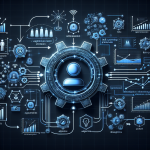Introduction to Personalized Landing Pages with AI
In today’s highly competitive digital landscape, user experience has become paramount. One of the most effective ways to enhance user engagement and increase conversion rates is through personalized landing pages. These are web pages customized to meet the preferences, behavior, or demographics of individual users. Artificial Intelligence (AI) plays a key role in automating and optimizing this personalization process, making it scalable and more effective than traditional methods.
Why Personalization Matters
Personalization increases relevance. When a user lands on a webpage that speaks directly to their needs or interests, they are more likely to take the desired action, whether it’s making a purchase, signing up for a service, or downloading content. Statistics show that personalized landing pages can increase conversion rates by up to 202%, establishing a strong business case for investing in this technology.
How AI Enables Smart Personalization
AI-driven personalization uses machine learning algorithms and data analytics to modify landing page content in real-time or through pre-configured user segments. Here’s how it works:
- Data Collection: AI collects and processes data such as location, browsing behavior, referral source, device type, and past interactions.
- User Segmentation: Based on collected data, AI can identify distinct customer segments automatically.
- Content Matching: The system selects or generates content variations tailored for each user or segment, optimizing headlines, images, CTAs, and more.
- Continuous Learning: Machine learning models continuously refine the personalization strategy by analyzing performance metrics such as bounce rate, time on page, and conversions.
Key AI Technologies Used
To personalize landing pages automatically, various AI technologies come into play:
- Natural Language Processing (NLP): Dynamically adapts headlines and copy based on user context and preferences.
- Predictive Analytics: Forecasts user intent and behavior to determine the most effective page elements.
- Computer Vision: Selects or modifies visual elements based on content relevance to the user.
- Recommendation Engines: Suggests products or content based on user similarity models.
Benefits of AI-Powered Landing Page Personalization
Implementing AI in landing page customization provides several advantages:
- Enhanced Conversion Rates: Tailoring content reduces friction and nurtures the user journey towards conversion.
- Scalability: AI enables businesses to personalize experiences for thousands or millions of users without manual intervention.
- Efficiency: Smart automation saves time and resources that would otherwise be spent on A/B testing and manual user segmentation.
- Real-Time Adaptability: AI reacts to visitor behavior instantaneously, ensuring that the most relevant content is always displayed.
Use Cases and Examples
Here are a few real-world examples of how businesses use AI to personalize landing pages:
- E-commerce: Displaying product recommendations based on browsing history and customer profile.
- SaaS Companies: Serving industry-specific case studies and testimonials to B2B prospects based on their IP data.
- Travel Websites: Tailoring offers and destinations based on geolocation and seasonality.
- Online Education: Recommending courses aligned with learners’ past achievements or interests.
Challenges and Considerations
Despite the benefits, deploying AI for dynamic landing page personalization isn’t without challenges:
- Data Privacy: Collecting and analyzing user data must comply with regulations like GDPR or CCPA.
- Technical Complexity: Integrating AI systems with existing CMS or marketing tools may require significant development effort.
- Content Bottleneck: A robust personalization strategy requires a library of varied, high-quality content assets.
- User Acceptance: Over-personalization can be perceived as invasive or creepy if not handled delicately.
Best Practices for Implementing AI in Landing Pages
To successfully leverage AI for landing page customization, consider the following best practices:
- Start with clear goals (e.g., lead generation, sales, sign-ups).
- Use privacy-first data collection strategies.
- Incorporate A/B and multivariate testing alongside AI recommendations.
- Ensure seamless integration with marketing automation and CRM systems.
- Regularly monitor AI outputs and intervene when necessary to maintain content quality.
The Future of Landing Page Personalization
As AI technology continues to evolve, we can anticipate even more granular and proactive personalization capabilities. With advances in generative AI, landing pages may soon be built on-the-fly for each visitor, offering truly one-to-one experiences personalized by a mix of text, visuals, and interactivity. Businesses that embrace these advancements will likely gain a significant competitive edge in user engagement and conversion success.
Conclusion
Automated personalization of landing pages using AI is revolutionizing how businesses approach digital marketing. With its ability to analyze user data, segment audiences, and tailor content on a massive scale, AI empowers marketers to create more relevant and engaging experiences. While challenges exist, strategic integration and careful planning can unlock the full potential of AI to drive user satisfaction and business growth.







